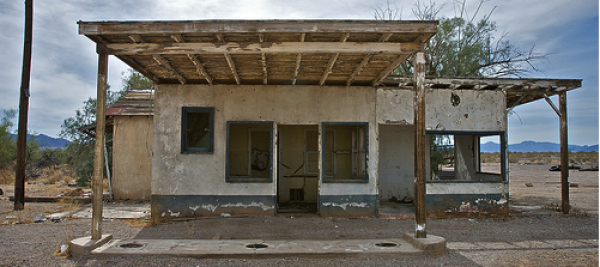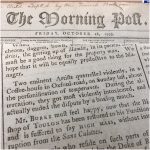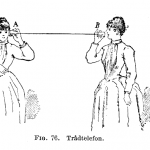
“Living in a Gas Station” by Julie Anne Lindsey
Essays, LiteratureAll across America, small, independent fuel stations have closed their doors. As a result, hundreds of abandoned properties pepper the landscape. Interstates and massive oil conglomerates have radically changed the face of our countryside, particularly in the Midwest.
In the great state of Ohio, on a scenic rural road, one family is feeling the burden of those changes. The Lindsey family is currently living on the site of a former gas station. The long gone Sherman Church Variety Store is now home to Bryan Lindsey, his wife Julie, and their three small children. For years, Bryan had no idea that he owned a contaminated property.
When the variety store closed its doors more than two decades back, four underground gas tanks were left behind. In 1991, the owner operator, Kenneth Walter had the tanks removed. The removal revealed a dangerous truth. An excessive amount of benzene, a component of gasoline, was found in the soil. One of the older storage tanks had been damaged and was leaking. Mr. Walter did not clean up the property. Instead, he put it on the market a few years later.
The half acre property was sold for an unusually good price. Bryan Lindsey, then only 19 years old, purchased it from Mr. Walter in 1996. Lindsey thought that he had landed an investment, recognizing the utterly unique opportunity to remodel the building. The Sherman Church Variety Store contained more than 1800 square feet of space. Lindsey began to renovate.
With the help of his father and two brothers, Lindsey turned the crumbling cinder block building into an inviting new home with an intriguing link to the local community. The renovation took more than 5 years and in 2002, Lindsey and his new wife moved in. Their years of sweat equity had really paid off, or so they believed.
Following the birth of the Lindseys’ first son, letters began to arrive addressed to the variety store. The return address was an environmental cleanup company. This was how the Lindseys learned the ugly truth. Their property, along with so many like it, was contaminated and abandoned. Cleanup was estimated in the six figure range, and benzene was a known carcinogen.
A division of the State Fire Marshall’s office, known as BUSTR (Bureau of Underground Storage Tank Removal) knew all about the contamination on Sherman Church. BUSTR had opened a case against Walter in 1991, but they never followed through.
The Lindseys contacted BUSTR directly to learn more about the case. Initially, they were told by David Biskner, a BUSTR representative, that they had nothing to worry about. The Lindseys were not responsible for the cleanup costs, and they were unlikely to be in any danger. However, Biskner added that they could not sell their property without disclosing the contamination to potential buyers. Biskner then sent the Lindseys a copy of the file on their property.
The BUSTR file revealed everything. There had been no follow up on the benzene contamination. The bureau had very few records of correspondence with Walter after the initial letter asking for him to clean it up. Since BUSTR’s initial contact with Walter, seventeen
years went by, the property was sold to the Lindseys, and Mr. Walter moved across the country. He now claims that he is financially unable to pay for any cleanup. He also had not taken out any insurance on the tanks. The Lindseys were stuck.
A more thorough investigation of the file showed that BUSTR had named the “harmless” levels of benzene to be unfit for both health and human safety. The Lindseys were terrified. Another year had passed without resolution, and another child had entered the Lindsey family. Mrs. Lindsey began an all out campaign for help.
As it turns out, sites like the Lindseys’ are painfully common to professionals in the field. A dozen phone calls and months of perseverance landed them one more lead. If the Lindseys could find someone in the local government who would intercede on their behalf, then they could apply for Clean Ohio Funds. Because their property had been an abandoned station, also known as a Brownfield, there was money available for testing. The Lindseys sought and found an ally.
The local township trustees took on the Lindsey family’s case and made arrangements to ask for help. It worked. In spring of 2008, the OEPA, met with Biskner and the Lindseys at the township trustee offices. Testing protocols were established, and a date was set. Several months later, Biskner met with OEPA geologists and soil specialists for two days of testing outside the Lindsey home. In addition to soil samples, the OEPA took well water samples from the Lindsey home as well as from their nearest neighbors’.
Nearly 200 pages were delivered on the results of that testing. The good news was that all well water samples were clear. The bad news was that the soil was still contaminated beyond the levels deemed acceptable by BUSTR. The case could not be closed and the benzene remained.
For the following year, the Lindseys petitioned for funds to perform cleanup. Initially, they were promised cleanup by the OEPA, then denied. The story changed. Soon, they were told that the OEPA could not interfere. It was a BUSTR case, not the EPA’s, and BUSTR had no funds for performing cleanups. BUSTR was only a monitoring agency.
A year later, President Obama allocated funds for cleanup to BUSTR for the first time, and the Lindseys inquired again. They contacted the Bureau Chief at the State Fire Marshall hoping to access the newly available funds. The Chief said that the Lindseys would be put on a list, and funds would be distributed according to need. Months passed, and there was no new news. An email to the Ohio State Director of Commerce, sent by the Lindseys, resulted in a second call from the Fire Marshall.
This time, the Lindseys were told that clean up funds were not available to them because the responsible party, Mr. Walter’s whereabouts were known. Walter was responsible until proven otherwise unviable. Unfortunately, Walter would not respond to inquiries about his finances. Until he was proven not to be financially viable, the Lindseys were not able to apply for clean up funds.
At that time, the Lindseys were in contact with an environmental attorney who suggested that they offer to hire a private investigator to look into Mr. Walter’s finances for BUSTR. BUSTR would not accept the findings. A year later, BUSTR turned the Lindsey case over to the
Attorney General. That is where it sits today. No one at the Attorney General’s office will return the Lindseys’ calls. Governor Strickland’s office states that it was not Strickland’s jurisdiction. The Director of Commerce, Kimberly Zurz, Strickland’s appointee, stopped responding to the Lindseys’ emails, and BUSTR has washed their hands of the case because it is now at the Attorney General’s office.
More than two years have passed since the Brownfield testing was performed. A third baby has joined the Lindsey family. They remain in a frightening and precarious situation, unable to make any further headway against the government agencies involved.
It is surely a sign of the times when a family can live in known contamination with no assistance from any of the multiple organizations that are in place to help them. Not even the Environmental Protective Agency will help. More than two decades after the contamination was discovered, it remains.
Now, one local family must worry about the health and safety of their children, play inside more than they want to, avoid planting a garden, and know that they cannot leave. How can a typical one income family buy a second home without the ability to sell the first? One mortgage is difficult enough to manage. Two would be impossible. So, the Lindsey family is trapped, living in a gas station.
This is my family’s story.























